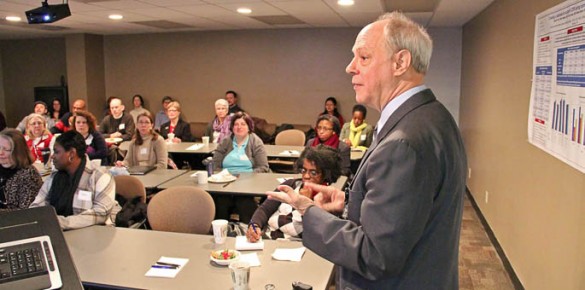
At a recent Community Research Partners meeting hosted by the Meharry-Vanderbilt Community Engaged Research Core (CERC), Bruce Behringer MPH, deputy commissioner for Continuous Improvement and Training for the Tennessee Department of Health, spoke on the value of the ‘Give-Get Grid.’
The Give–Get Grid is an easy-to-use tool that can assist in planning, maintaining and evaluating academic-community partnerships. The model draws upon social psychology, business practice and community development theories to assist in program and community partnership development.
“What we found was there were greater numbers of contributions and benefits that people found at the end of their program than they had at the beginning,” Behringer said. “There were all these unexpected things that came up because we have this relationship. It promotes mutual understanding, trust and longer-term relationships. Bottom line, it requires a mission; it requires commitment.”
The presentation sparked a dynamic group discussion about the importance of meaningful partnerships and ensuring that communities are engaged in health initiatives.
“As a community partner focused on healthier living for communities, we welcome the opportunity to partner with academic researchers and others to strengthen the goal of improving the health of the individuals in our communities. We are better together,” said Ted Cornelius, vice president of Health Innovation for the YMCA of Middle Tennessee.
Bryn Bakoyema, director, Research and Evaluation at the Martha O’Bryan Center said that the Give-Get Grid is a straightforward tool that can be applied to various partnerships to build strong collaborations.
“As a non-profit, I can envision using this tool with University partners and when working with community members and other community organizations.”
Community involvement in research was described as difficult by some, and examples were given of obstacles that were experienced. Stephania Miller-Hughes, Ph.D., associate director of CERC, talked about the community listening sessions sponsored by CERC.
“We are going into different communities and asking them what their priorities are. We’re asking them how we should use their research dollars,” Hughes said. “This is an important step in understanding the values and needs of the community.”
Consuelo H. Wilkins, M.D., MSCI, executive director of the Meharry-Vanderbilt Alliance said that building and maintaining community relationships is an ongoing process.
“We have a long way to go before we’re actually getting to research that is community driven…but I think we have more of a commitment now than there has been a strong effort to really understand what the community’s needs are.”
Understanding these needs and providing support for investigators conducting community engaged research is a large focus of CERC.
Yvonne Joosten, manager of CERC added that “Mr. Behringer’s presentation really got to the heart of CERC’s mission, which is to foster mutually beneficial academic-community partnerships to improve community health.”
To find out more about CERC and its services, contact Joosten at yvonne.joosten@vanderbilt.edu or 936-5260.
— by Joe Baker












